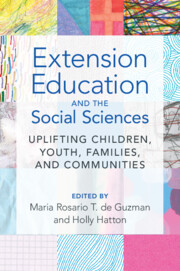Book contents
- Extension Education and the Social Sciences
- Extension Education and the Social Sciences
- Copyright page
- Contents
- Contributors
- Part I Overview of Extension and the Social Sciences
- Chapter 1 Introduction
- Chapter 2 Engaged Scholarship
- Chapter 3 Extension’s Role in Promoting Resilience among Rural Families with Low Incomes
- Chapter 4 Extension Programming to Enhance Urban Well-Being
- Part II Addressing Key Issues in the Well-Being of Children, Youth, and Families
- Part III Looking Ahead: Emerging Issues and Trends
- Index
- References
Chapter 4 - Extension Programming to Enhance Urban Well-Being
from Part I - Overview of Extension and the Social Sciences
Published online by Cambridge University Press: 28 March 2024
- Extension Education and the Social Sciences
- Extension Education and the Social Sciences
- Copyright page
- Contents
- Contributors
- Part I Overview of Extension and the Social Sciences
- Chapter 1 Introduction
- Chapter 2 Engaged Scholarship
- Chapter 3 Extension’s Role in Promoting Resilience among Rural Families with Low Incomes
- Chapter 4 Extension Programming to Enhance Urban Well-Being
- Part II Addressing Key Issues in the Well-Being of Children, Youth, and Families
- Part III Looking Ahead: Emerging Issues and Trends
- Index
- References
Summary
Extension’s commitment to improving the quality of life through nonformal education remains apparent across the rural–urban continuum. While urban, suburban, and rural communities share common issues such as food access and health disparities, addressing concerns of well-being in urban areas requires approaches that recognize the scale, diversity, complexity, and urban–rural interface of metropolitan areas. This chapter provides an overview of Extension’s strategy in metropolitan areas. It describes and discusses the National Urban Extension Leaders (NUEL) network, which is a steering council developed to guide Extension’s approach to urban programming. NUEL’s focus areas include improving our health, enriching youth, feeding the future, strengthening communities, and protecting the environment. Using a case study approach, the chapter then includes examples of Extension programs across the country that address issues relevant to urban populations. The chapter concludes with insights from earlier programming and scholarship, and provides recommendations based on a synthesis of common threads and unique considerations in urban programming.
- Type
- Chapter
- Information
- Extension Education and the Social SciencesUplifting Children, Youth, Families, and Communities, pp. 64 - 94Publisher: Cambridge University PressPrint publication year: 2024



